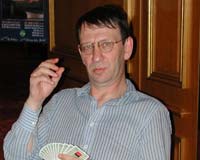| 35th World Interzonal Team Championships, Paris, France | Friday, 2 November 2001 |
|
USA II vs Poland
The favored Polish team trailed by 23 IMPs going into the fifth set of their semifinal Bermuda Bowl match against USA II, seeking to reach the final with Rose Meltzer, the first woman to play in even the semifinal stage of the championship with the current format. The strong Polish team had their work cut out for them as they faced two pairs with extensive world-level experience, including a few world titles: Chip Martel-Lew Stansby and Alan Sontag-Peter Weichsel. Against that lineup, the Poles fielded Krzysztof Martens-Marcin Lesniewski and Cezary Balicki-Adam Zmudsinski. Martens was tested on the first deal, but he came through.
Zmudzinski led the ª7 to dummy's ace, and Weichsel led a low heart from dummy, winning the king with the ace. He continued with the §Q and §K, ducked by North, who won the third round of clubs with the ace and returned the §7 to Weichsel's 10. He ended with four hearts, two spades and three clubs for plus 150.
Martel took the winning view of his marginal hand on the next
deal to help his side to a 6-IMP gain.
Balicki's aggressive move toward game resulted in a minus score. The play record is incomplete, but Balicki went one down on the lead of the §9 by Weichsel.
Martel's simple preference to spades paid off well when Stansby played it expertly to bring home an overtrick. He won the lead of the §8 in dummy with the king and played a spade to his 10 and West's ace. Another club came back and Stansby compressed his club winners by putting in dummy's queen so as to take another spade finesse. When the suit proved to be 3-3, he had nine tricks in four spades, three clubs and two hearts. The Americans' lead grew even more when an aggressive bid by
Weichsel paid off.
A takeout double with the East hand would not be everyone's choice because of the shortage in spades, but Weichsel did have a strong hand. Sontag understood that on the bidding and raised himself to the good game. Sontag ruffed the opening lead of the ©A and played a spade to the ace, followed by a low spade, ensuring a spade ruff and the contract. When the §Q fell doubleton, that was for an overtrick and + 620.
(1) 11-15 with 4 spades, 5 hearts. Martel liked his extra trump and the fact that all his high cards were in partner's two long suits, so he made an invitational bid of 3©, effectively shutting the Poles out of the auction. Stansby had five top losers and could have lost another trick had Lesniewski not won the first round of spades. Stansby's small minus compared favourably with his teammates' vulnerable game bonus. That was 11 IMPs to USA II. The two teams traded pushes for the next three boards before
Poland hit the Americans with a vulnerable game swing on Board
7.
One can sympathize with the Americans' dilemma on this deal after Balicki's super-aggressive pre-empt in hearts. Weichsel has a powerful hand opposite a takeout double, so a bid of 4ª doesn't seem to do it justice. On the other hand, is Sontag supposed to bid a three-card spade suit holding five diamonds to the K-Q? Zmudzinski did not err on opening lead, starting with the §K. Weichsel ducked but South continued with a club, so he had one to cash when he came in with the ¨A. It was a tough -100 for Weichsel and Sontag.
Martel took it easy with his 2-point hand, giving the Poles a little breathing room. They took advantage of it by getting just high enough. Lesniewski made 12 tricks when Stansby started with a low heart instead of a club honor. That was 13 IMPs to Poland, who picked up another 6 IMPs when Weichsel misjudged an opponent's spade length on the following deal.
Lesniewski opened 1NT and declined Martens' game invitation after a Stayman sequence. Stansby led a low spade to the 5, 10 and jack, and Lesniewski went to work on hearts. When spades proved to be 6-2, Lesniewski ended up with nine tricks for +150. Weichsel also played in 2NT, also on an invitational sequence involving Stayman, and he got the same opening lead. But when North won the first heart and returned a spade, Weichsel went up with the ace and, apparently planning to endplay South after he cashed his presumed three spade winners, got out with his ª2. Unfortunately for Weichsel, South had four spade winners to cash. Along with the top hearts, that gave the Poles +100 and 6 IMPs. Poland trailed by 20 near the end when they claimed a slam swing
to move even closer.
The largely artificial sequence after Zmudzinski's light opener got the Poles to the excellent heart slam. There was nothing to the play and Zmudzinksi duly chalked up +980.
(1) Flannery with a fourth-seat range of 11-18. Stansby might have checked on partner's strength, but it must have been difficult to envision all those aces and kings in just the right spots. The way to guarantee getting to slam with the North/South cards was to open the bidding with the South hand - not the Americans' style. The 11-IMP swing brought Poland to within 9 IMPs, and they closed out the set having trimmed 10 IMPs off the 23-IMP deficit. It would be anybody's match in the final set. | |||||||||||||||||||||||||||||||||||||||||||||||||||||||||||||||||||||||||||||||||||||||||||||||||||||||||||||||||||||||||||||||||||||||||||||||||||||||||||||||||||||||||||||||||||||||||||||||||||||||||||||||||||||||||||||||||||||||||||||||||||||||||||||||||||||||||||||||||||||||
| Page 2 |

